

The Science of Performance Improvement. HPT-Model-2012.jpg (JPEG Image, 953 × 728 pixels) What Is HPT? Human Performance Technology (HPT), a systematic approach to improving productivity and competence, uses a set of methods and procedures -- and a strategy for solving problems -- for realizing opportunities related to the performance of people.
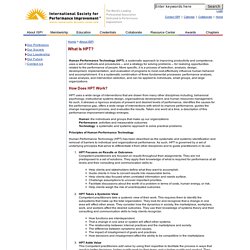
More specific, it is a process of selection, analysis, design, development, implementation, and evaluation of programs to most cost-effectively influence human behavior and accomplishment. It is a systematic combination of three fundamental processes: performance analysis, cause analysis, and intervention selection, and can be applied to individuals, small groups, and large organizations. How Does HPT Work? HPT uses a wide range of interventions that are drawn from many other disciplines including, behavioral psychology, instructional systems design, organizational development, and human resources management.
Principles of Human Performance Technology View the Complete Standards (PDF) The HPT Model. How to Conduct a Training Needs Analysis. Training needs analysis process is a series of activities conducted to identify problems or other issues in the workplace, and to determine whether training is an appropriate response.
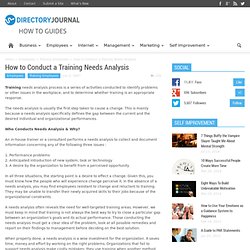
The needs analysis is usually the first step taken to cause a change. This is mainly because a needs analysis specifically defines the gap between the current and the desired individual and organizational performances. Who Conducts Needs Analysis & Why? An in-house trainer or a consultant performs a needs analysis to collect and document information concerning any of the following three issues : 1. In all three situations, the starting point is a desire to effect a change.
A needs analysis often reveals the need for well-targeted training areas. When properly done, a needs analysis is a wise investment for the organization. Richard Branson on Growing Your Business by Building a Community. Richard Branson When you're launching a startup, one of your first tasks is to identify potential customers and learn about their needs.
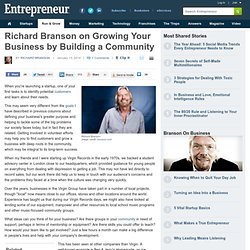
This may seem very different from the goals I have described in previous columns about defining your business's greater purpose and helping to tackle some of the big problems our society faces today, but in fact they are related. Getting involved in volunteer efforts may help you to find customers and grow a business with deep roots in the community, which may be integral to its long-term success. When my friends and I were starting up Virgin Records in the early 1970s, we backed a student advisory center in London close to our headquarters, which provided guidance for young people on everything from dealing with depression to getting a job.
Emergent Learning Model. WikiQuals. Affinity Groups. v6p153-168Lim258.pdf. Educational offerings guidelines overview - CPsquare. The Community of Practice on Communities of Practice. The Single Greatest Reason The World’s Workforce Is Disengaged. “No problem can be solved until it is reduced to some simple form.

The changing of a vague difficulty into a specific, concrete form is a very essential element in thinking.” J. P. Morgan In the early part of this past summer, Gallup released its “State of the American Workforce” report – a massive research undertaking that identified how connected and contented people feel in their jobs. The news got even worse a few days ago when Gallup announced the results of its global workplace study. Take a look at these worldwide results: Soon after the U.S. engagement report was released, I interviewed Dr. But now, four months later, I’m left to wonder how the world’s economy succeeds by having just 13% of the working population fully committed to excellence? With the hope that Gallup’s new research might shed new light on this engagement crisis, I reached out to Dr.
Video: A better approach to teamwork at The Asana Blog. 5 Critical Design Activities for Creating Impactful e-Learning. 5 Critical Design Activities for Creating Impactful e-Learning Posted by Ethan Edwards on Mon, Aug 12, 2013 by Ethan Edwards, chief instructional strategist | @ethanaedwards Last week I presented a webinar for ASTD, Five Critical Design Activities for Creating Impactful e-Learning.

E-Learning and Employee Onboarding - Designing the Right Blend from Start to Finish. Even in the current climate, savvy organizations know you still need - more than ever, really – to attract and retain great people.
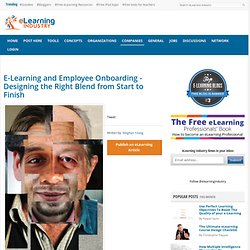
Your approach to onboarding is in the front line in the war for talent. What kind of first impression are you creating? Are you exploring the potential of e-learning and a portal approach within your onboarding to extend your reach? The nature of the modern workforce means more remote and geographically dispersed workers. There’s an increase in the distribution of full time, part time, and contractor employees – all of whom need some form of onboarding. Douglas Engelbart’s Unfinished Revolution. Doug Engelbart knew that his obituaries would laud him as “Inventor of the Mouse.”
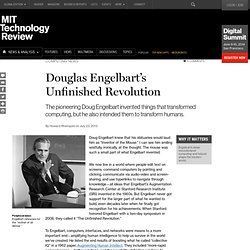
I can see him smiling wistfully, ironically, at the thought. Modernising the L&D function: From learning gatekeeper to learning concierge. I have written a lot about how knowledge workers are using the Social Web to organise their own learning and performance support and how this is changing the face of workplace learning such that the new role of Traning & Development (T&D) will be to support these new ways of self-organised learning.
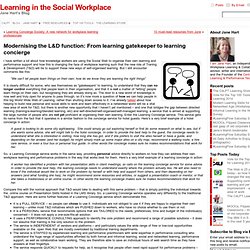
But I still encounter comments like this: “We can’t let people learn things on their own; how do we know they are learning the right things” It is clearly difficult for some, who see themselves as “gatekeepers” to learning, to understand that they can no longer control everything that people learn in their organisation, and that it is not a matter of “letting” people learn things on their own, but recognising they are already doing so. 3 emerging services of the L&D Department. Actually, They're Not Headcount - They're People. » What Coursera can teach corporations about doing learning differently. One of the emerging trends in the training and development field is the shift from “trainer” to “community manager.”
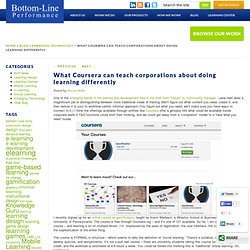
Jane Hart does a magnificent job of distinguishing between more traditional views of training (We’ll figure out what content you need, create it, and then deliver it to you) to workflow-centric informal approach (You figure out what you need; we’ll make sure you have ways to connect to it.) » This Week on #TalkTech: Real mLearning, Compulsion Loops in Gamification and Schools and Workplaces of the Future. #TalkTech is the “flipped” approach to Twitter chats.
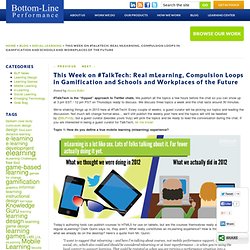
We publish all the topics a few hours before the chat so you can show up at 3 pm EST / 12 pm PST on Thursdays ready to discuss. We discuss three topics a week and the chat lasts around 30 minutes. We’re shaking things up in 2013 here at #TalkTech! Every couple of weeks, a guest curator will be picking our topics and leading the discussion. Not much will change format-wise… we’ll still publish the weekly post here and the topics will still be tweeted by @BLPIndy, but a guest curator (besides yours truly) will pick the topics and be ready to lead the conversation during the chat. KM Concept: Tacit and Explicit Knowledge. The distinction between tacit and explicit knowledge is perhaps the most fundamental concept of knowledge management. Such a distinction was first made by Michael Polyani in the 1960s, but it forms one of the central planks of Nonaka and Takeuchi's book The Knowledge-Creating Company.
According to them, 'explicit' knowledge is formal and systematic[1]: "Explicit knowledge can be expressed in words and numbers and can be easily communicated and shared in the form of hard data, scientific formulae, codified procedures or universal principles. " Such knowledge is seen as "only the tip of the iceberg". 'Tacit' knowledge, on the other hand, is described as: Asana · Task Management for Teams. Moodle_For_Motivation-v.05. Bartle player types. Bartle Player Types - part 2. Bartles Player Types and Assessment preferences. Learning pyramid. Learning-Pyramid - part 2.